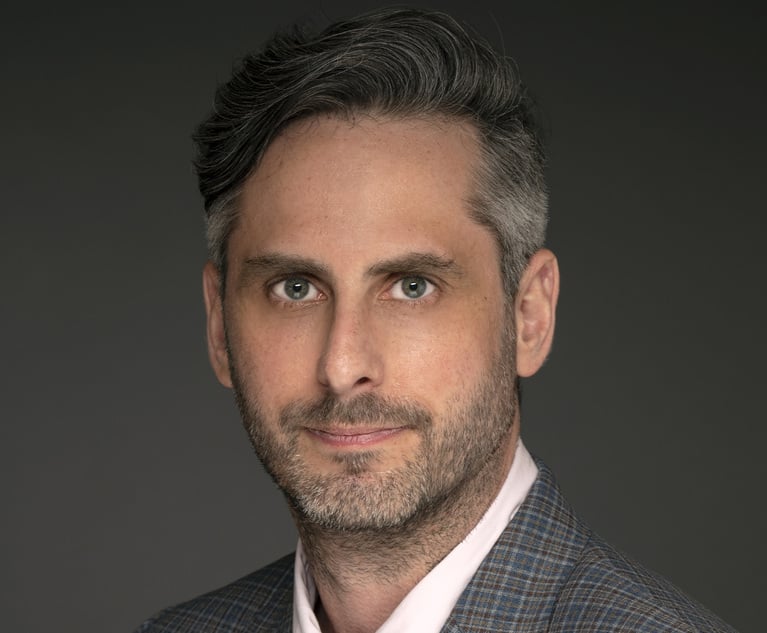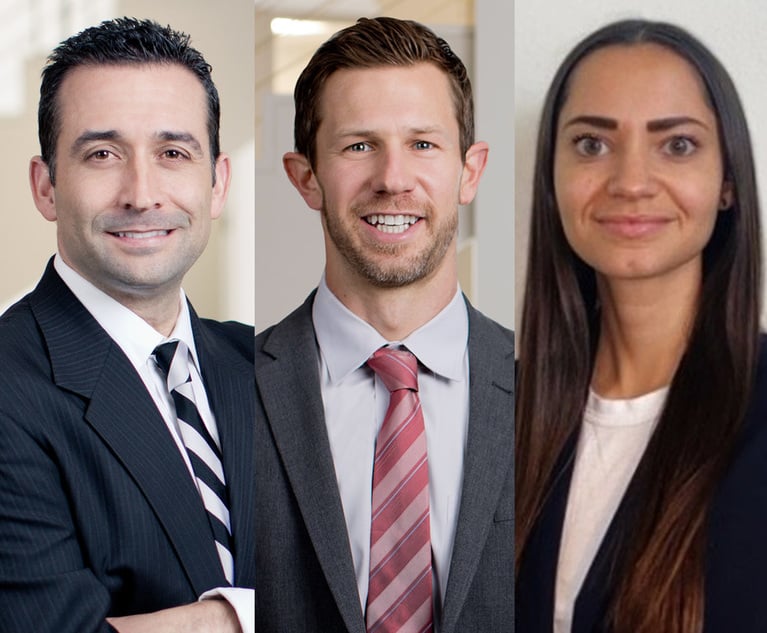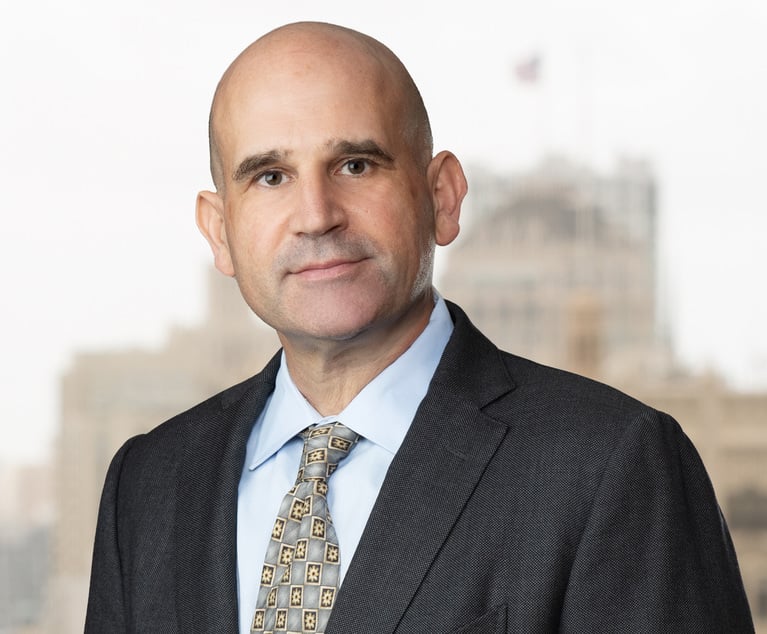UCLA's Richard Sander Plods Ahead in Latest 'Mismatch' Theory Lawsuit
The law professor is headed back to court, seeking admission and outcome records from the University of California system that he believes will substantiate his theory, which posits affirmative action actually hurts minority students.
November 29, 2018 at 10:01 AM
7 minute read
 Richard Sander. Photo: Jamie Rector.
Richard Sander. Photo: Jamie Rector.
It has been a busy month for Richard Sander, the polarizing University of California at Los Angeles School of Law professor whose controversial “mismatch theory” claims that affirmative action policies actually hurt some minority students by thrusting them into academic situations where they are more likely to struggle.
He's spent years fighting the State Bar of California to obtain ethnicity and bar pass data that would allow him to look at how individual law students performed on the licensing exam. Earlier this month, the California Supreme Court declined to take up his appeal. (A trial court judge ruled against Sander in 2016, as did an appellate court earlier this year.)
But Sander isn't giving up. He filed a lawsuit in state court on Nov. 15 seeking to compel the University of California system to turn over admissions and outcomes data. Sanders expects the data to show that the 10 campuses within the system are using racial preferences to admit more black and Hispanic students, despite Proposition 209—the 1996 law prohibiting public universities in the state from granting any racial preferences in admissions—and provide further evidence of his mismatch theory.
He obtained a similar data set from the University of California 10 years ago, but now university officials say providing the data would require the creation of a customized database. Moreover, a system spokeswoman said its schools don't consider race in admissions.
Law.com caught up with Sander this week to discuss the new lawsuit and the professional price he has paid for taking on affirmative action. His answers have been edited for length and clarity.
You have been working on your mismatch theory for a long time—since 2003. When you started, did you think you'd still be working on it 15 years later and that it would define you as an academic? That certainly wasn't the goal. I thought when I did my first piece—a systemic analysis in the Stanford Law Review that came out in January of 2005—there would be an awakening of interest and concern on this, and there would be a groundswell to seek change. I was dismayed to see how resilient academic institutions were to the revelations in that article.
Did you know at the time how controversial the mismatch theory would be? Sure, I knew the article would be controversial. But when people checked it against the facts, I believed they would see the facts were correct and that would lead to a demand for change. In 2005, there was a period where things did change. Admissions offices did change their policies that year. I have good data from a number of public law schools that shows the size of [racial] preferences used went down. All the initial signs were good, but then there was a pretty powerful reaction by, I would say, the affirmative action establishment.
Do you think you have paid a professional price for taking on such a fraught issue and pursuing it relentlessly? Absolutely. The elite law schools are not comfortable inviting me as a speaker to discuss my scholarship the way that colleagues do. When I'm asked to speak somewhere, it's almost always in a debate format as opposed to just presenting my ideas. There are occasionally actions among the students at UCLA that target me, usually based on not having any idea what my research actually is, but the general reaction is that this is anti-PC research and should be resisted. There have also been opportunities to engage in a broader discussion about affirmative action. I've made my peace with the advantages and disadvantages of going public on these issues. The goal here is to try to improve minority achievement and to diversify the legal profession. If we can't have a discussion about something that's that well-intentioned, then we're kind of in bad shape as institutions dedicated to uncovering truth.
You said the research of mismatch within law schools has become stronger. Tell me about that. I was able to get through other public records requests data from three other law schools like the kind we were trying to get from the [California] bar. It didn't have bar scores, which helps the precision, but it did have individual bar outcomes—pass fail outcomes—that we can link to individual credentials. With this data, we can measure individual levels of mismatch. We can see how far each person is from the median of the class. It's the first time in the law school context we can directly measure mismatch levels and tie it to bar outcomes. It's very compelling. It shows stronger mismatch results than I found in my earlier analysis.
Is the Harvard litigation, where Asian-American applicants claim they were discriminated against, part of what you see as a larger push to look at preferences in admissions? It's related, but a somewhat different issue. I started this mismatch research in the early 2000s. Around that time, other scholars became interested in mismatch as well. There have now been something like 25 or 30 pretty good studies done looking at mismatch. I'd say 80 percent find pretty strong evidence of the mismatch we're talking about. That has changed the debate on affirmative action in general. It has shifted it so there is the old thinking about whether it's more fair to be race blind or race conscious. And there's the newer debate of whether being race conscious even helps the people that you're supposed to help. That's the mismatch issue. Then there's other new issues of affirmative action, which is the Asian-American issue. If we're going to be race conscious, is it legitimate to discriminate against groups that have historically experienced discrimination? That's what is raised by the Harvard suit, and by this new [University of California] suit that we filed.
So tell me about the new University of California suit. You say that you believe schools within the system have increased their use of racial preferences during the past decade and you want to examine the data. What's distinct about the [University of California] suit is that we're sort of uniting the Asian issue with the mismatch issue. I have a lot of allies in the Asian-American community who are very concerned about the anti-Asian discrimination. I'm very concerned about that, too. We're also more generally concerned about violations of Prop. 209. There's a lot of research now showing that when the University of California was forced to become more race neutral in the late 1990s, it ended up benefiting all groups. It certainly produced a short-term increase in Asian-American admission rates.
It also led the university to rethink its approach to underrepresented minorities. The university started building better pipelines to disadvantaged schools and doing a much better job of helping California high school students understand their requirements. All that meant the number of black and Hispanic students getting bachelor's degrees at the university dramatically increased. That's a story most of the media has almost religiously ignored [because coverage has instead focused on declines in black and Hispanic enrollment at the prestigious Berkeley and UCLA campuses, even though minority enrollment increased throughout the wider system].
The concern is that if [University of California] goes back to being race conscious, it will go back to the bad old practices and mismatch will become a serious problem again. You'll have this combination of discrimination and preferences that hurts everyone.
This content has been archived. It is available through our partners, LexisNexis® and Bloomberg Law.
To view this content, please continue to their sites.
Not a Lexis Subscriber?
Subscribe Now
Not a Bloomberg Law Subscriber?
Subscribe Now
NOT FOR REPRINT
© 2024 ALM Global, LLC, All Rights Reserved. Request academic re-use from www.copyright.com. All other uses, submit a request to [email protected]. For more information visit Asset & Logo Licensing.
You Might Like
View All
How the Deal Got Done: Sidley Austin and NWSL Angel City Football Club/Iger

How Uncertainty in College Athletics Compensation Could Drive Lawsuits in 2025

How I Made Practice Group Chair: 'Think About Why You Want the Role, Because It Is Not an Easy Job,' Says Aaron Rubin of Morrison Foerster

Outgoing USPTO Director Kathi Vidal: ‘We All Want the Country to Be in a Better Place’
19 minute readTrending Stories
Who Got The Work
Michael G. Bongiorno, Andrew Scott Dulberg and Elizabeth E. Driscoll from Wilmer Cutler Pickering Hale and Dorr have stepped in to represent Symbotic Inc., an A.I.-enabled technology platform that focuses on increasing supply chain efficiency, and other defendants in a pending shareholder derivative lawsuit. The case, filed Oct. 2 in Massachusetts District Court by the Brown Law Firm on behalf of Stephen Austen, accuses certain officers and directors of misleading investors in regard to Symbotic's potential for margin growth by failing to disclose that the company was not equipped to timely deploy its systems or manage expenses through project delays. The case, assigned to U.S. District Judge Nathaniel M. Gorton, is 1:24-cv-12522, Austen v. Cohen et al.
Who Got The Work
Edmund Polubinski and Marie Killmond of Davis Polk & Wardwell have entered appearances for data platform software development company MongoDB and other defendants in a pending shareholder derivative lawsuit. The action, filed Oct. 7 in New York Southern District Court by the Brown Law Firm, accuses the company's directors and/or officers of falsely expressing confidence in the company’s restructuring of its sales incentive plan and downplaying the severity of decreases in its upfront commitments. The case is 1:24-cv-07594, Roy v. Ittycheria et al.
Who Got The Work
Amy O. Bruchs and Kurt F. Ellison of Michael Best & Friedrich have entered appearances for Epic Systems Corp. in a pending employment discrimination lawsuit. The suit was filed Sept. 7 in Wisconsin Western District Court by Levine Eisberner LLC and Siri & Glimstad on behalf of a project manager who claims that he was wrongfully terminated after applying for a religious exemption to the defendant's COVID-19 vaccine mandate. The case, assigned to U.S. Magistrate Judge Anita Marie Boor, is 3:24-cv-00630, Secker, Nathan v. Epic Systems Corporation.
Who Got The Work
David X. Sullivan, Thomas J. Finn and Gregory A. Hall from McCarter & English have entered appearances for Sunrun Installation Services in a pending civil rights lawsuit. The complaint was filed Sept. 4 in Connecticut District Court by attorney Robert M. Berke on behalf of former employee George Edward Steins, who was arrested and charged with employing an unregistered home improvement salesperson. The complaint alleges that had Sunrun informed the Connecticut Department of Consumer Protection that the plaintiff's employment had ended in 2017 and that he no longer held Sunrun's home improvement contractor license, he would not have been hit with charges, which were dismissed in May 2024. The case, assigned to U.S. District Judge Jeffrey A. Meyer, is 3:24-cv-01423, Steins v. Sunrun, Inc. et al.
Who Got The Work
Greenberg Traurig shareholder Joshua L. Raskin has entered an appearance for boohoo.com UK Ltd. in a pending patent infringement lawsuit. The suit, filed Sept. 3 in Texas Eastern District Court by Rozier Hardt McDonough on behalf of Alto Dynamics, asserts five patents related to an online shopping platform. The case, assigned to U.S. District Judge Rodney Gilstrap, is 2:24-cv-00719, Alto Dynamics, LLC v. boohoo.com UK Limited.
Featured Firms
Law Offices of Gary Martin Hays & Associates, P.C.
(470) 294-1674
Law Offices of Mark E. Salomone
(857) 444-6468
Smith & Hassler
(713) 739-1250






